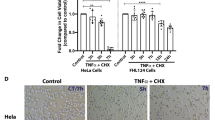Abstract
Purpose
To investigate the effects of adenovirus-mediated transfer of antisense c-myc construct on human lens epithelial B-3 (HLE B-3) cell proliferation, apoptosis and cell cycle.
Methods
HLE B-3 cell cultures were transduced with replication-defective adenovirus bearing either a nuclear-targeted β-galactosidase (Ad-lacZ) or an antisense c-myc construct (Ad-AS-myc). The presence of β-galactosidase activity in the transduced cultures was detected by immunohistochemical X-Gal staining, while c-myc mRNA and protein expression levels were evaluated by RT-PCR and Western blot analysis. HLE B-3 cell proliferation within 96 h after the transduction was analyzed by cell counting and MTT colorimetric assay. Apoptosis and cell cycle of the HLE-B3 cells were examined by flow-cytometric analysis.
Results
The mean transduction efficiency was 80% for HLE B-3 cells. Downregulation of c-myc mRNA and protein expression was noticed at 48, 96 and 144 h after the transduction with Ad-AS-myc. Cytostatic effects of Ad-AS-myc in HLE B-3 cells were obvious within 96 h after the transduction. An increased incidence of apoptosis and G1-phase arrest was identified in the Ad-AS-myc-transduced HLE B-3 cells.
Conclusions
HLE B-3 cells were successfully transduced with adenovirus-mediated antisense c-myc construct. Ad-AS-myc transduction could significantly inhibit cell proliferation and induce cell apoptosis and G1-phase arrest in HLE B-3 cells. It may provide a novel approach for prevention of posterior capsular opacification.



Similar content being viewed by others
References
Apple DJ, Solomon KD, Tetz MR, Assia EI, Holland EY, Legler UF, Tsai JC, Castaneda VE, Hoggatt JP, Kostick AM (1992) Posterior capsule opacification. Surv Ophthalmol 37:73–116
Capeans C, Pineiro A, Dominguez F, Loidi L, Buceta M, Carneiro C, Garcia-Caballero T, Sanchez-Salorio M (1998) A c-myc antisense oligonucleotide inhibits human retinal pigment epithelial cell proliferation. Exp Eye Res 66:581–589
Carroll JS, Swarbrick A, Musgrove EA, Sutherland RL (2002) Mechanisms of growth arrest by c-myc antisense oligonucleotides in MCF-7 breast cancer cells: implications for the antiproliferative effects of antiestrogens. Cancer Res 62:3126–3131
Chen JP, Lin C, Xu CP, Zhang XY, Fu M, Deng YP, Wei Y, Wu M (2001) Molecular therapy with recombinant antisense c-myc adenovirus for human gastric carcinoma cells in vitro and in vivo. J Gastroenterol Hepatol 16:22–28
De Nigris F, Sica V, Herrmann J, Condorelli G, Chade AR, Tajana G, Lerman A, Lerman LO, Napoli C (2003) c-Myc oncoprotein: cell cycle-related events and new therapeutic challenges in cancer and cardiovascular diseases. Cell Cycle 2:325–328
Heufelder AE, Bahn RS (1995) Modulation of cellular functions in retroorbital fibroblasts using antisense oligonucleotides targeting the c-myc protooncogene. Invest Ophthalmol Vis Sci 36:1420–1432
Hodge WG (1992) Posterior capsule opacification after cataract surgery. Ophthalmology 105:943–944
Ismail MM, Alio JL, Ruiz Moreno JM (1996) Prevention of secondary cataract by antimitotic drugs: experimental study. Ophthalmic Res 28:64–69
Iversen PL, Arora V, Acker AJ, Mason DH, Devi GR (2003) Efficacy of antisense morpholino oligomer targeted to c-myc in prostate cancer xenograft murine model and a Phase I safety study in humans. Clin Cancer Res 9:2510–2519
Legler UF, Apple DJ, Assia EI, Bluestein EC, Castaneda VE, Mowbray SL (1993) Inhibition of posterior capsule opacification: the effect of colchicine in a sustained drug delivery system. J Cataract Refract Surg 19:462–470
Mirza MA, Weber J (1979) Uncoating of adenovirus type 2. J Virol 30:462–471
Nishi O (1986) Incidence of posterior capsule opacification in eyes with and without posterior chamber intraocular lenses. J Cataract Refract Surg 12:519–522
Pastorino F, Brignole C, Marimpietri D, Pagnan G, Morando A, Ribatti D, Semple SC, Gambini C, Allen TM, Ponzoni M (2003) Targeted liposomal c-myc antisense oligodeoxynucleotides induce apoptosis and inhibit tumor growth and metastases in human melanoma models. Clin Cancer Res 9:4595–4605
Pelengaris S, Khan M (2003) The c-MYC oncoprotein as a treatment target in cancer and other disorders of cell growth. Expert Opin Ther Targets 7:623–642
Prall OW, Rogan EM, Musgrove EA, Watts CK, Sutherland RL (1998) c-myc or cyclin D1 mimics estrogen effects on cyclin E-Cdk2 activation and cell cycle reentry. Mol Cell Biol 18:4499–4508
Simile MM, De Miglio MR, Muroni MR, Frau M, Asara G, Serra S, Muntoni MD, Seddaiu MA, Daino L, Feo F, Pascale RM (2004) Down-regulation of c-myc and Cyclin D1 genes by antisense oligodeoxy nucleotides inhibits the expression of E2F1 and in vitro growth of HepG2 and Morris 5123 liver cancer cells. Carcinogenesis 25:333–341
Smith JB, Wickstrom E (1998) Antisense c-myc and immunostimulatory oligonucleotide inhibition of tumorigenesis in a murine B-cell lymphoma transplant model. J Natl Cancer Inst 90:1146–1154
Wen Y, Shu S, Unakar NJ, Bekhor I (1992) Expression of c-myc protooncogene in rat lens cells during development, maturation and reversal of galactose cataracts. Mol Cell Biochem 112:73–79
Acknowledgements
This work was supported by a grant from the Shandong Natural Science Foundation (Y2003C04), PR China. The authors thank Dr. Youhai Chen, University of Pennsylvania, for kindly providing the HLE B-3 cell line, Drs. Chen Lin and Qimin Zhan, Chinese Academy of Medical Sciences Institute of Oncology, for kindly providing the Ad-lacZ and Ad-AS-myc, and Ms. Ping Lin for her editorial assistance.
Author information
Authors and Affiliations
Corresponding author
Rights and permissions
About this article
Cite this article
Sun, J., Xie, L., Wang, Y. et al. Inhibition of human lens epithelial B-3 cell proliferation by adenovirus-mediated transfer of antisense c-myc construct. Graefe's Arch Clin Exp Ophthalmol 243, 601–606 (2005). https://doi.org/10.1007/s00417-004-1095-4
Received:
Revised:
Accepted:
Published:
Issue Date:
DOI: https://doi.org/10.1007/s00417-004-1095-4




